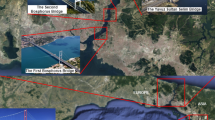Abstract
Damage alarming and safety evaluation using long-term monitoring data is an area of significant research activity for long-span bridges. In order to extend the research in this field, the damage alarming technique for bridge expansion joints based on long-term monitoring data was developed. The effects of environmental factors on the expansion joint displacement were analyzed. Multiple linear regression models were obtained to describe the correlation between displacements and the dominant environmental factors. The damage alarming index was defined based on the multiple regression models. At last, the X-bar control chart was utilized to detect the abnormal change of the displacements. Analysis results reveal that temperature and traffic condition are the dominant environmental factors to influence the displacement. When the confidence level of X-bar control chart is set to be 0.003, the false-positive indications of damage can be avoided. The damage sensitivity analysis shows that the proper X-bar control chart can detect 0.1 cm damage-induced change of the expansion joint displacement. It is reasonably believed that the proposed technique is robust against false-positive indication of damage and suitable to alarm the possible future damage of the expansion joints.
Similar content being viewed by others
References
KO J M, NI Y Q. Technology developments in structural health monitoring of large-scale bridges [J]. Engineering Structures, 2005, 27(12): 1715–1725.
DOEBLING S W, FARRAR C R, PRIME M B. A summary review of vibration-based damage identification methods [J]. The Shock and Vibration Digest, 1998, 30(2): 91–105.
DENG Yang, DING You-liang, LI Ai-qun. Fatigue reliability assessment for bridge welded details using long-term monitoring data [J]. Science China Technological Sciences, 2011, 54(12): 3371–3381.
DENG Yang, DING You-liang, LI Ai-qun. Prediction of extreme wind velocity at the site of the Runyang Suspension Bridge [J]. Journal of Zhejiang University: Science A, 2011, 12(8): 605–615.
NI Y Q, HUA X G, FAN K Q, KO J M. Correlating modal properties with temperature using long-term monitoring data and support vector machine technique [J]. Engineering Structures, 2005, 27(12): 1762–1773.
DING You-liang, DENG Yang, LI Ai-qun. Study on correlations of modal frequencies and environmental factors for a suspension bridge based on improved neural networks [J]. Science China: Technological Sciences, 2010, 53(9): 2501–2509.
CORNWELL P, FARRAR C R, DOEBLING S W, SOHN H. Environmental variability of modal properties [J]. Experimental Techniques, 1999, 23(6): 45–48.
DING You-liang, LI Ai-qun. Temperature-induced variations of measured modal frequencies of steel box girder for a long-span suspension bridge [J]. International Journal of Steel Structures, 2011, 11(2): 145–155.
CHEN Wai-fa, DUAN Lian. Bridge engineering handbook [M]. Boca Raton: CRC Press, 2000.
NI Y Q, HUA X G, WONG K Y, KO J M. Assessment of bridge expansion joints using long-term displacement and temperature measurement [J]. Journal of Performance of Constructed Facilities, 2007, 21(2): 143–151.
LI Ai-qun, MIAO Chang-qing, LI Zhao-xia, HAN Xiao-lin, WU Sheng-dong, JI Lin, YANG Yu-dong. Health monitoring system for the Runyang Yangtse Rriver Bridge [J]. Journal of Southeast University: Natural Science Edition, 2003, 23(5): 544–548. (in Chinese)
ZHANG Q W, FAN L C, YUAN W C. Traffic-induced variability in dynamic properties of cable-stayed bridge [J]. Earthquake Engineering and Structural Dynamics, 2002, 31(11): 2015–2021.
CHEN J, XU Y L, ZHANG R C. Modal parameters identification of Tsing Ma suspension bridge under typhoon Victor: EMD-HT method [J]. Journal of Wind Engineering and Industrial Aerodynamics, 2004, 92(10): 805–827.
FUGATE L M, SOHN H, FARRAR C R. Vibration-based damage detection using statistical process control [J]. Mechanical Systems and Signal Processing, 2001, 15(4): 707–721.
KULLAA J. Damage detection of the Z24 bridge using control charts [J]. Mechanical Systems and Signal Processing, 2003, 17(1): 163–170.
DERAEMAEKER A, REYNDERS E, de ROECK G, KULLAA J. Vibration-based structural health monitoring using output-only measurements under changing environment [J]. Mechanical Systems and Signal Processing, 2008, 22(1): 34–56.
Author information
Authors and Affiliations
Corresponding author
Additional information
Foundation item: Project(2009BAG15B03) supported by the National Science and Technology Ministry of China; Projects(51178100, 51078080) supported by the National Natural Science Foundation of China; Project(BK2011141) supported by the Natural Science Foundation of Jiangsu Province, China; Project(12KB02) supported by the Open Fund of the Key Laboratory for Safety Control of Bridge Engineering (Changsha University of Science and Technology), Ministry of Education, China
Rights and permissions
About this article
Cite this article
Miao, Cq., Deng, Y., Ding, Yl. et al. Damage alarming for bridge expansion joints using novelty detection technique based on long-term monitoring data. J. Cent. South Univ. 20, 226–235 (2013). https://doi.org/10.1007/s11771-013-1480-4
Received:
Accepted:
Published:
Issue Date:
DOI: https://doi.org/10.1007/s11771-013-1480-4




